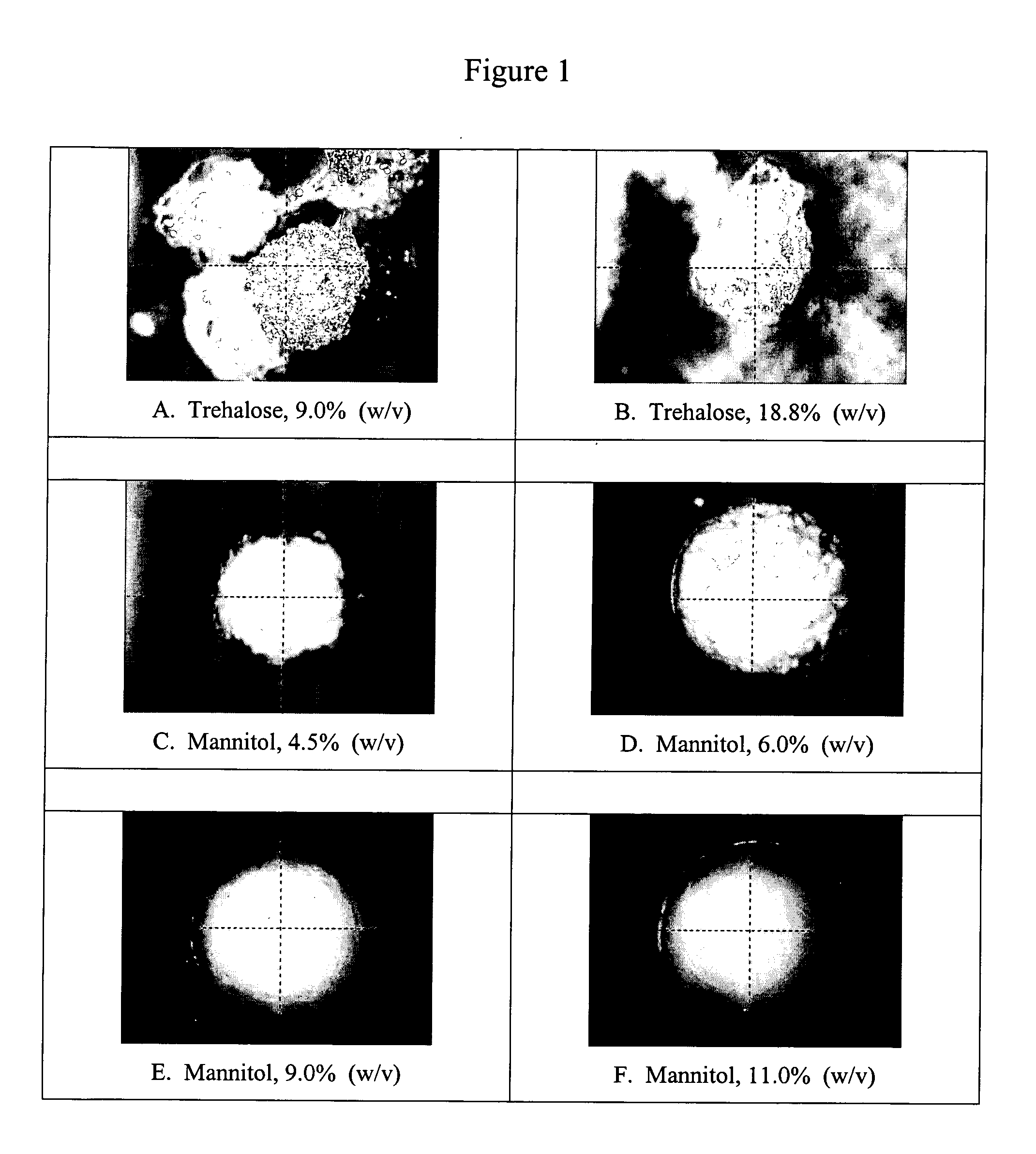Lyophilized beads containing mannitol
a technology of lyophilized beads and mannitol, which is applied in the direction of biochemistry apparatus and processes, enzymology, transferases, etc., can solve the problems of frequent experimental errors, inefficiency and accompanying errors, and introduce additional errors into the experimen
- Summary
- Abstract
- Description
- Claims
- Application Information
AI Technical Summary
Benefits of technology
Problems solved by technology
Method used
Image
Examples
example 1
[0086] Bead Production
[0087] The lyophilized beads of the invention were produced in a three step process: A) buffer creation; B) bead formation; and C) bead lyophilization.
[0088] A) Buffer Creation
[0089] HEPES sodium salt hydrate (2.16 g; MW=260.3), HEPES (0.405 g; MW=238.3), Excipient(s) (See Table 1 for amounts), KCl (0.448 g; MW=74.55), MgCl2 (0.23 g; MW=95.21), Bovine Serum Albumin (BSA) (0.18 g), and 2-Methyl-4-IsoThiazolin-3-one (MIT) (0.10 g; MW=151.6) were individually added to a stirred solution of water, which was then brought to a final volume of 100 mL. Stirring was accomplished with a stir bar and stir plate. Each component was allowed to dissolve completely before the next component was added. The pH of this buffer system was measured to ensure it was at pH 8.00+ / −0.1. The buffer system was next filtered using a sterile 0.2 μm Corning brand Vacuum Filter / Storage System. A clean stirring bar was added to the filtered lyophilization buffer solution, and then Tween 20...
example 2
[0096] Characterization of the Lyophilized Beads
[0097] Several physical characteristics of the beads were measured, including: cross-section, shape, roughness, size uniformity, bead integrity, extent of crystallinity, structure, moisture content, and phase transition temperature.
[0098] i. Bead Cross-Section
[0099] Bead cross-section was measured using the See-Brez Video Microscope (Quality Control Solutions Inc., Temecula, Calif.). Three beads from each excipient formulation of Table 1 were measured. Each bead was measured twice, for a total of six measurements per excipient formulation. Raw and statistical data are shown in Table 3.
TABLE 3Trehalose% w / vMannitol % w / v18.89.04.56.07.08.09.011.0Unit(mm)(mm)(mm)(mm)(mm)(mm)(mm)(mm)Bead #12.28901.82602.17802.81902.81952.93202.86712.87002.54301.77152.20202.82452.75952.86352.71452.8435Bead #22.44702.01602.15152.76052.63752.80102.83652.88652.16752.07102.21702.73652.70952.78402.71492.8300Bead #32.18751.82122.21302.88352.66552.85902.8265...
example 3
[0115] Use of the Lyophilized Beads in the Detection of Bacillus Anthracis using Real-Time Polymerase Chain Reaction (RT-PCR)
[0116]Bacillus Anthracis is the bacteria which causes the acute infectious disease anthrax in humans. A rapid RT-PCR assay utilizing the lyophilized beads of the invention was used for the detection of this bacteria.
[0117] Two types of lyophilized beads were added to the PCR vial in this assay. The first type was a generic bead (GB), which, in addition to the components specified in Example 1, contained a “Hotstart” Platinum DNA polymerase. Hotstart polymerases are precomplexed with specific monoclonal antibodies to render the polymerase inactive. The second bead type was an assay specific bead (ASB), which, in addition to the Example 1 components, also contained primers for Bacillus Anthracis and probes. One of each type of bead was placed in the PCR vial. A sample containing lysed Bacillus Anthracis bacteria was then added to the PCR vial, along with enoug...
PUM
| Property | Measurement | Unit |
|---|---|---|
| volume | aaaaa | aaaaa |
| volume | aaaaa | aaaaa |
| length | aaaaa | aaaaa |
Abstract
Description
Claims
Application Information
 Login to View More
Login to View More - R&D
- Intellectual Property
- Life Sciences
- Materials
- Tech Scout
- Unparalleled Data Quality
- Higher Quality Content
- 60% Fewer Hallucinations
Browse by: Latest US Patents, China's latest patents, Technical Efficacy Thesaurus, Application Domain, Technology Topic, Popular Technical Reports.
© 2025 PatSnap. All rights reserved.Legal|Privacy policy|Modern Slavery Act Transparency Statement|Sitemap|About US| Contact US: help@patsnap.com

